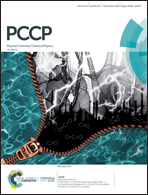Bimetallic Al–Sn clusters: mixing at the nanoscale†
Abstract
Metals which are not miscible in the bulk solid phase can form clusters at the nanoscale, and a typical example is the Al–Sn system. We have investigated the reasons for the enhanced miscibility occurring at the nanoscale. Density functional calculations have been performed for small AlmSnn clusters at all compositions when the total number of atoms N = m + n is equal to or smaller than N = 6, and for selected compositions for N = 10 and N = 11. The cohesive energies show that the clusters are energetically stable with respect to the separated atoms. Also, after an AlmSnn cluster has formed, its separation into two pure clusters Alm and Snn is energetically forbidden. This justifies the observation that those clusters can form by condensation in gas phase experiments. The different miscibility criteria explored reveal a substantial dependence on the reference state. Between those miscibility criteria, a particularly valuable one consists in studying the substitution reactions in which an Al atom of the gas replaces a Sn atom of the AlmSnn cluster to produce Alm+1Snn−1, or a Sn atom replaces an Al atom to produce Alm−1Snn+1. The conclusion is that substitution reactions enriching the clusters in Sn and depleting the cluster in Al are favorable. However, AlSn10 is an exception to this general trend. This is a special cluster. It readily forms by replacing a Sn atom by an Al atom in Sn11. Also, AlSn10 forms easily by adding an Al atom to Sn10. The geometric structures of Sn11 and Sn10 easily reorganize to form AlSn10 accommodating the Al atom inside a Sn cage. The exceptionally stable character of AlSn10 justifies the identification of AlSn10 as a magic cluster with the highest population in the measured mass spectra of this family. Even if Al and Sn can form clusters, the degree of mixing of these two elements in the clusters is modest, and a tendency for segregation of Al and Sn atoms on different parts of the cluster is incipient.



 Please wait while we load your content...
Please wait while we load your content...